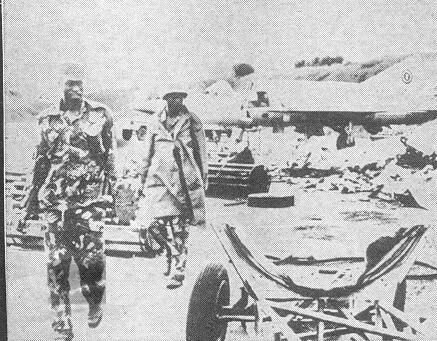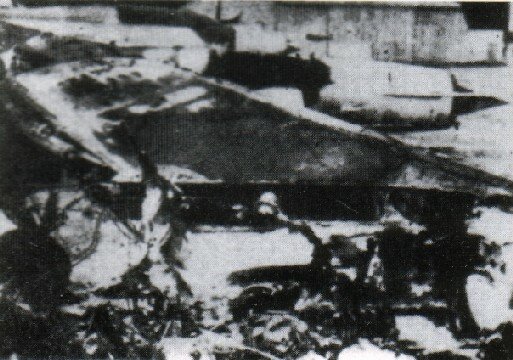|
From ACIG.org Central, Eastern, & Southern Africa Database
The infamous Ugandan tyrant Idi Amin Dada came to power during a British-supported coup against President Milton Obote, in 1971. Amin's brutal and bloody rule caused many of his opponents to flee to Tanzania, where they were organized and armed, and prepared for an invasion of Uganda, with the main target of toppling Idi Amin. In early September 1972, Amin launched an operation of "anti-Asian" ethnic cleansing, expelling almost all of Ugandan 50,000 Asians and seizing their property. Although Amin proclaimed that the "common man" was the beneficiary of this action - which proved immensely popular - it was actually the Ugandan Army that emerged with the houses, cars, and businesses of the departing Asian minority. The expropriation of property proved disastrous for the already declining economy: businesses were ruined, cement factories at Tororo and Fort Portal collapsed from lack of maintenance, and sugar production literally ground to a halt, as unmaintained machinery jammed permanently. Uganda's export crops were sold by government parastatals, but most of the foreign currency they earned went for purchasing imports for the army. Ugandan rural population, previously producing coffee, turned to smuggling, especially to Kenya. The smuggling problem became an obsession of Amin; toward the end of his rule, he appointed his mercenary adviser, the former British citizen Bob Astles, to take all necessary steps to eliminate the problem. These steps included orders to shoot smugglers on sight. Parallel to these actions, Amin also revised Ugandan foreign politics. Re-discovering his - previously neglected - Islamic heritage - he expelled all the remaining Israeli military advisers (to who he was much indebted), and then requested foreign aid from Saudi Arabia while ordering construction of a great mosque on Kampala Hill, in the Ugandan capital (this was never completed because most of the money disappeared). Simultaneously, Amin secured also financial and military aid from Libya. Obote and his followers in Tanzania finally decided to launch an attempt to remove Amin. Their first such operation, undertaken on 17 September 1972, was launched on 17 September 1972, when a small armed contingent travelling in 77 trucks crossed the border from Tanzania to Uganda. Their objective was the capture of the southern Ugandan military post at Masaka. Instead of continuing their advance, Obote's fighters then settled down, waiting for a general uprising against Amin - which naver occurred.
With this, the whole enterprise was doomed to failure as the dictator called Libyans for help. Col. Qaddaffi immediately reacted by swiftly dispatching up to 3,000 troops, five Lockheed C-130H Hercules transports and – apparently – several Dassault LARAF Mirage 5Ds to Entebbe airfield, in southern Uganda. The presence of Libyan troops and aircraft was felt immediately, then beginning on 20 September 1972, the Ugandan Army started a counteroffensive, with the MiG-17s and MiG-21s of the Ugandan Army Air Force flying a series of strikes against different objectives in Tanzanian cities of Bukoba and Mwanza. Subsequently, Ugandan and Libyan troops managed to drive the rebels back into Tanzania. This improved the relations between Uganda and Libya and secured Amin’s rule so far that Idi Amin declared Uganda an “Islamic Republic”.
By summer 1978 Amin's circle of close associates was shrinking, as a number of his aides either defected or were executed. Eventually, the one reliable Malire Mechanized Regiment of the Ugandan Army mutinied. Some of the mutineers fled across the Tanzanian border joining the newly-established National Liberation Front (NLF), organized and armed by Chinese. When Amin learned that the NLF was preparing an offensive into Uganda, in October 1978, he ordered a pre-emptive military attack against Tanzania. The onslaught was spearheaded by a series of strikes against Bukoba from 10 October onward, flown by Ugandan MiG-17s and MiG-21s. Most of these were ineffective, then the remaining UAAF pilots at the time were poorly trained, their aircraft in sad shape, and insufficiently armed. However, Ugandan troops - supported by some M4 Sherman tanks - managed to cross the border and occupy the town of Kyaka, where up to 8,000 civilians were massacred, while thousands of others forced to flee.
Within the following week the small but well trained Tanzanian Defence Forces were mobilized, and the resistance started to build up. On 28 October 1978, the first Ugandan MiG-17 was shot down by an SA-7 near Bukoba, and subsequently, another Ugandan fighter was lost while attacking a bridge near Kyaka. By November, Tanzanians stopped Ugandan advance, and by late December 1978, all Ugandan troops were expelled from Tanzania. That yet meant no end to the fighting, because in early January 1979 Tanzanians started a single offensive into Uganda, as a sort of peace-enforcing operation, with the main task of putting an end to Idi Amin’s rule. On 20 January 1979, up to 10,000 Tanzanian troops - supported by Chinese-supplied T-59A tanks and MiG-21MF - crossed the border and started an advance deep into Uganda. By late March, the Libyan garrison at Entebbe was effectively under siege, and the Ugandan Army was on the verge of total collapse. In a vain attempt to save the situation, Ghaddafi swiftly dispatched two Tu-22Bs of the 1110th Sqn LARAF - under command of Col. Mathelon - to Nakasangola airfield, north of Kampala. On the early morning of 1 April 1979, one of these two aircraft flew the first – and the only combat sortie – undertaken by the type during that conflict. In a shabby bullying attempt of “power projection” aimed at Tanzanians, the bomber dropped 20 FAB-250 bombs at the town of Mwanza, but missed completely.
On the contrary, Tanzanian AF reacted with a series of strikes by MiG-21MFs (Tanzania has not got any J-6s or J-7s by the time, as usually reported) against Kampala, Jinja and Tororo which mainly damaged the morale of Ugandan troops, even if not causing much damage. The presence of the Libyan forces and aircraft could not prevent the Tanzanian troops from running over Uganda, and Libyans started evacuating their troops. Idi Amin immediately resigned, and fled aboard a LARAF C-130Hs to Saudi Arabia. Subsequently, however, the Tanzanians tightened their grip on Entebbe, and on 7 April 1979, a C-130H (serial 116) was shot down by an RPG-7 round during take-off from that airfield, which was subsequently captured by Tanzanian troops.
By late May 1979, airfields at Gulu and Nakasangola were captured as well, and all Ugandan MiG-17s and MiG-21s found there were by the time either destroyed or captured by the Tanzanians: two MiG-17s and a single MiG-21MF were already shot down; two or three intact MiG-17s and several MiG-21s were captured intact and taken to Tanzania as war booty, while four irreparable MiG-21s were dumped at a local scrap yard.
On 3 June 1979, Tanzanian troops reached the Sudanese border, and the remnants of Amin’s army were forced to capitulate. This article is largely based on excerpts from feature "Bombed by Blinders: Tuplev Tu-22s in Action", by Tom Cooper, Farzad Bishop & Arthur Hubers, published in AirEnthusiast magazine, volumes No.116 (March/April 2005) and No.117 (May/June 2005). Except for own research and materials kindly supplied by contributors on ACIG.org forum, as well as from Mr. Tom N. and Mr. Pit Weinert, the following sources of reference were used: - "AIR WARS AND AIRCRAFT; A Detailed Record of Air Combat, 1945 to the Present", by Victor Flintham, Arms and Armour Press, 1989 - "CONTINENT ABLAZE; The Insurgency Wars in Africa, 1960 to the Present" by John W. Turner, Arms and Armour 1998 (ISBN: 1-85409-128-X) - "AFRICAN MiGs; MiGs and Sukhois in Service in Sub Saharan Africa" by Tom Cooper, SHI Publications 2004 (ISBN: 3-200-00088-0)
© Copyright 2002-3 by ACIG.org |








